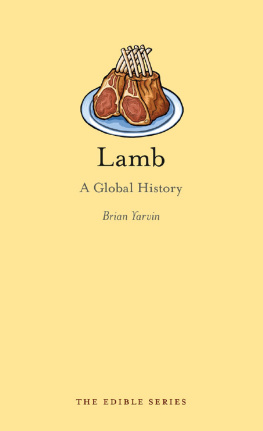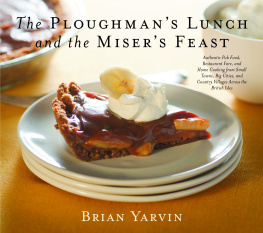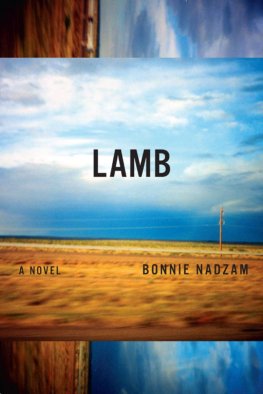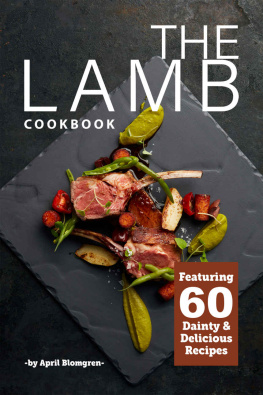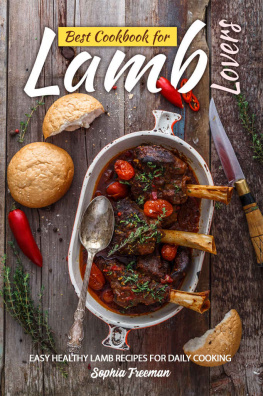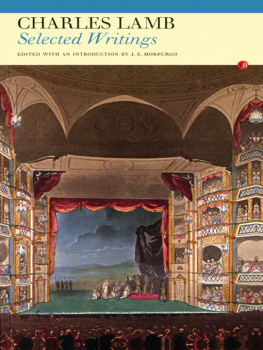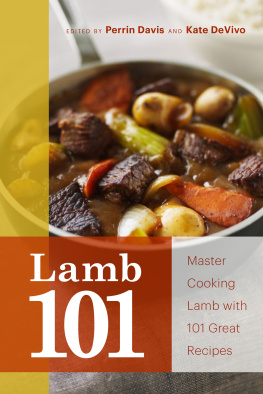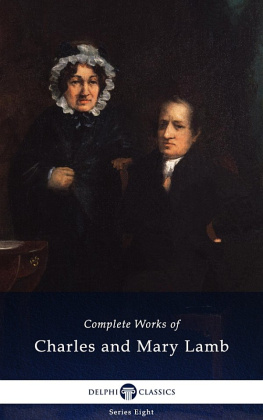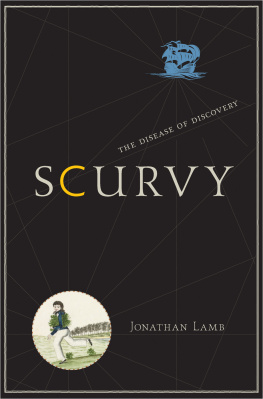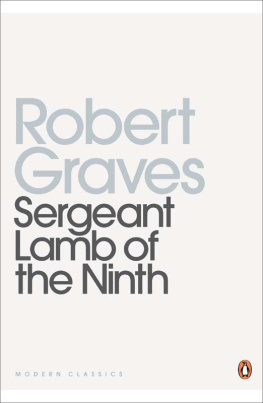LAMB

Edible
Series Editor: Andrew F. Smith
EDIBLE is a revolutionary series of books dedicated to food and drink that explores the rich history of cuisine. Each book reveals the global history and culture of one type of food or beverage.
Already published
Apple Erika Janik Barbecue Jonathan Deutsch and Megan
J. Elias Beef Lorna Piatti-Farnell Beer Gavin D. Smith
Brandy Becky Sue Epstein Bread William Rubel
Cake Nicola Humble Caviar Nichola Fletcher
Champagne Becky Sue Epstein Cheese Andrew Dalby
Chocolate Sarah Moss and Alexander Badenoch
Cocktails Joseph M. Carlin Curry Colleen Taylor Sen
Dates Nawal Nasrallah Doughnut Heather Hunwick
Dumplings Barbara Gallani Eggs Diane Toops
Figs David C. Sutton Game Paula Young Lee
Gin Lesley Jacobs Solmonson Hamburger Andrew F. Smith
Herbs Gary Allen Hot Dog Bruce Kraig Ice Cream Laura B.
Weiss Lamb Brian Yarvin Lemon Toby Sonneman
Lobster Elisabeth Townsend Milk Hannah Velten
Mushroom Cynthia D. Bertelsen Nuts Ken Albala
Offal Nina Edwards Olive Fabrizia Lanza Oranges Clarissa
Hyman Pancake Ken Albala Pie Janet Clarkson
Pineapple Kaori O Connor Pizza Carol Helstosky
Pork Katharine M. Rogers Potato Andrew F. Smith
Pudding Jeri Quinzio Rice Renee Marton Rum Richard Foss
Salmon Nicolaas Mink Sandwich Bee Wilson Sauces Maryann
Tebben Sausage Gary Allen Soup Janet Clarkson
Spices Fred Czarra Sugar Andrew F. Smith Tea Helen Saberi
Tequila Ian Williams Truffle Zachary Nowak Vodka Patricia
Herlihy Water Ian Miller Whiskey Kevin R. Kosar
Wine Marc Millon
Lamb
A Global History
Brian Yarvin
REAKTION BOOKS
To my wife, a woman who always loves a well-braised lamb shank
Published by Reaktion Books Ltd
33 Great Sutton Street
London EC1V 0DX, UK
www.reaktionbooks.co.uk
First published 2015
Copyright Brian Yarvin 2015
All rights reserved
No part of this publication may be reproduced, stored in a retrieval system, or transmitted, in any form or by any means, electronic, mechanical, photocopying, recording or otherwise, without the prior permission of the publishers
Page references in the Photo Acknowledgments and
Index match the printed edition of this book.
Printed and bound in China by Toppan Printing Co. Ltd
A catalogue record for this book is available from the British Library
eISBN: 9781780235431
Contents

Introduction

What is it about lamb? It is the meat of choice for ambitious chefs and cooking-show contestants, yet there are carnivores who just will not touch it. Somehow, for some reason, lamb is an emotive meat. It is not this way everywhere; lamb is consumed with gusto in South Asia and is found in every British high-street butcher shop.
Today, the very sight of sheep grazing tells us weve left the sprawl of modern life and reached a place where people are continuing ancient traditions of working with nature. In North America, vendors of lamb meat, sheeps milk cheese and even locally produced wool are returning to contemporary farmers markets.
What exactly is lamb? It is the meat of sheep that are slaughtered before they reach the age of one. This results in a fraction of the amount of meat you would get from a pig, a cow or, for that matter, an adult sheep. Not only is this meat of very high quality, but it can be raised easily on very small patches of land. Lamb is the perfect meat for the modern small farmer.
Lamb is perfectly suited to small-scale farming for the very same reasons the first farmers appreciated it: it is relatively easy to raise and sells well. Not only do sheep eat grass, but they can make a big meal from a small patch of it. They do not need to roam far and wide, as cows do, and do not require extra feed the way pigs do.
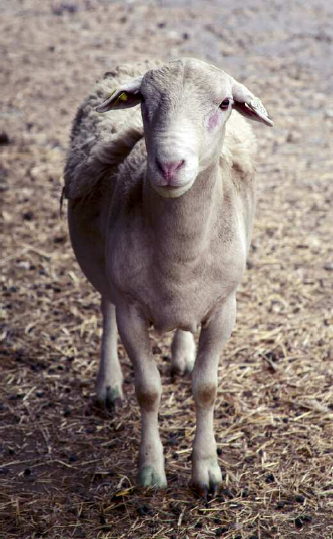
Ram at Dayspring Farm in Vermont.
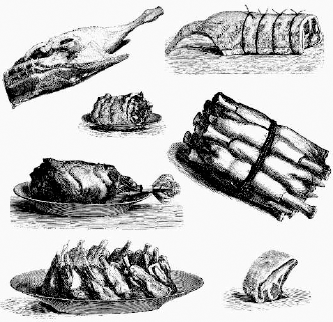
Engraving of a collection of seven lamb dishes from Le livre de cuisine (1874) by Jules Goufe.
Lamb is not the only sheep meat eaten by humans. Mutton, the meat of sheep slaughtered after the age of one, was once popular everywhere. Today, it remains so in Africa, parts of Asia and Latin America, while Britain is having a serious mutton revival complete with an endorsement for its consumption from the Prince of Wales. Still, lamb is more popular by far. Youll find lamb in soups and stews and on skewers and barbecue grills. Close your eyes and imagine a plate of grilled lamb chops in an alpine village trattoria, a bowl of spicy lamb noodle soup at a Xian street stall, a deep-fried lamb samosa in a Pakistani restaurant or those grilled mutton kidneys that James Joyce spoke of, with butter, salt and pepper... lamb is the true global red meat.
Lamb is food, metaphor and mythology. Since the domestication of sheep almost 10,000 years ago, lamb has found its way into scripture, literature and culture: think of the Golden Fleece, Blood of the Lamb or The Lamb Lies Down on Broadway. So lets sit down and take a look at just what lamb is and how it got that way. It is quite a story.

Butchery, from the Tacuinum sanitatis (Handbook of Health), 14th century.
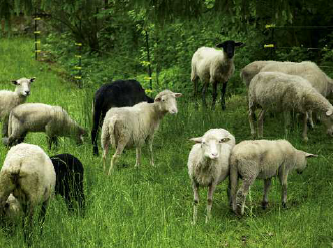
Sheep grazing at Burningheart Farm in New Jersey.
Basics: Sheep and Lamb

Ten or eleven thousand years ago, a hunting party heard a strange bleating sound. It was unlikely to be familiar: the wild sheep they had been stalking were not only shy, but spent most of their time high in the mountains on rocky terrain on which humans were not too comfortable.
Realizing that what they heard was an injured animal, they crept towards it quietly, thinking, Heres an easy meal. Moments later, they found themselves staring at a suffering, pregnant sheep. At first, they were going to put the animal out of its misery on the spot, but they soon had the idea of bringing it to camp and nursing it back to health and why not? If the sheep gave birth, they would save themselves another hunt; if it died, they would still have an animals worth of meat. They took the poor sheep back and soon they had it and a couple of baby ones as well. Those hunters were the proud owners of the first domestic lambs.
Once those lambs were born, the hunters saw a wholly different animal. Docile, and almost obedient, they were easy to keep and formed herds that would stay together without much pressure from the outside. The only problem was breeding those first lambs in captivity. Should they capture more animals for diversitys sake or just mate brothers and sisters?

